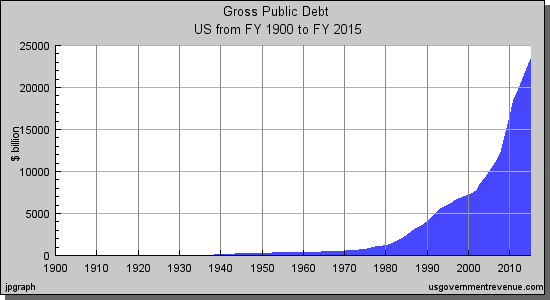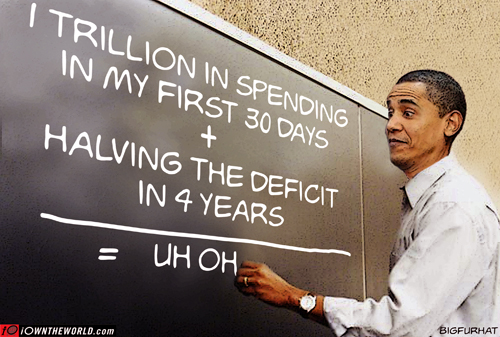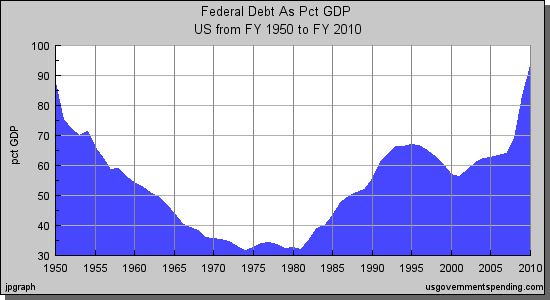02.16.2011
05.17.2011 updated broken link
08.25.2012 updated / replaced broken links

Obama’s Proposed $1.1 Trillion Budget Cut is Not Exactly “Deficit Reduction”
original article written by Net Advisor™
Excerpt:
The 2011 Obama Budget will actually increase net government spending, not decrease it as Obama’s speech was “advertised” on TV and in the papers. And worse, the President’s own numbers show the National Debt is on target to jump 130% in 10 years from when Obama took office.Read the real story that includes public data directly from the Congressional Budget Office (CBO) and the White House’s own economic projections you won’t want to miss. This is not some conspiracy story, it’s your money! Read More:
The White House announced that President Obama’s 2012 budget would reduce the deficit by $1.1 Trillion by the time Obama’s first term end in 2012 (Source: Reuters). The news of the day may lead the public to believe that after two years of record spending, President Obama is now all about deficit reduction?
We’ll, not exactly.
There is an important distinction between reducing the national debt and reducing annual government spending. The talk of reducing government spending especially in an election year sounds good from the headlines, and that is as far as the Obama Administration wants you to read.
Unfortunately what we have here is more Obama Math.
What should be noted is that President Obama is not going to reduce any deficit spending by $1.1 Trillion by 2012, that this is merely Obama’s goal to reduce the annual government spending by $1.1 Trillion over TEN years, not by 2012. What this means is that the government is attempting to not spend an extra $100 some billion per year, over the next 10 years. This does not by any stretch mean that the Obama Administration is going to reduce the NATIONAL DEFICIT by any amount over the next 10 years or at any time in the future.

Political Posturing
Obama is attempting to show he is really more of a centrist after two years of creating a bigger and more controlling government – a Socialistic ideology. All this really is Political Posturing, a smoke and mirror attempt to make people think that Obama is Clintonesque. Obama met with former President Bill Clinton in December 2010 in part to figure how to re-market Obama from the left ideologue to appear to be more “centrist” in order to appeal to voters in his 2012 re-election bid (Sources: Washington Post, FAIR.org).
Freezing Spending is Not Cutting Spending
President Obama has moved to place a short term (5 year) government freeze on speeding. The challenge here is that spending is already exceeding revenue, thus creating these massive deficits. So freezing spending is just going to keep the deficits building bigger and bigger. In short, freezing government spending for a short term is not cutting spending, nor is it deficit reduction. How can the Obama Administration argue that they are saving money when at the same time they continue to borrow money at a record pace? Yet, that in a nut shell is the Obama Administration’s “deficit savings” plan.
Obama Math Example:
1. You have $1.00 in revenue (income).
2. You then borrow $1.10
3. Then you put out a press release that you are cutting spending by say 10% over the next 10 years.
Question: Did you really reduce your deficit?
Answer: No. Over 10 years we have gained $10.00 in revenue but borrowed $11.00 total. We still have $1.00 of debt. But, remember we “cut spending” by 10% over 10 years so we still end up having a net debt of 90 cents (Reducing 10% from $1.00 of debt = .90 cents debt). Bottom line: We are still in debt. All we did is borrow a little less, but we still continued to borrow nonetheless. This is not deficit reduction, and this is how the Obama Administration is handling the deficit – borrowing just 10% less.
Shell Game
The Obama Administration plans to freeze spending in some areas then raising taxes and increase spending in other areas, is really just a shell game moving money from one government spending program to another new government spending program.
If President Obama was serious about cutting government spending, he and Congress would do the following:
1.Take the total amount of tax revenues and move 20% from that to reduce the national debt.
2. The remainder of the tax revenues is what the government can use for spending for that year.
Anything that goes beyond this will only increase the national debt. The rest of the country has hopefully learned to downsize and live within their means as necessary; however government continues to spend to no end and without regard to long term consequences to the economy and jobs.
Big Spender
President Obama’s spending since he came to office is running twice as fast that President Bush spent over 8 years and is the largest government spending increase since 1945.
“The deficits of $1.4 trillion in 2009 and $1.3 trillion in 2010 are, when measured as a share of gross domestic product (GDP), the largest since 1945…”
— The Budget and Economic Outlook (2011-2021). A Report by The Congressional Budget Office (PDF summary page)
If that debt wasn’t enough to get American voters in a frenzy, the 2011 deficit is on track to ADD another $1.48 Trillion up from $1.07 Trillion projected just last August 2010:
“The U.S. budget deficit this year (2011) will jump nearly 40 percent over prior forecasts…(and)…will hit $1.48 trillion, up from last August’s $1.07 trillion estimate.”
— Source: Reuters
Notice that the deficit will INCREASE, NOT decrease like the Obama Administration will try and make you believe.
Still Bush Bashing?
The CBO partially blames the extension of the 2001 “Bush Tax Cuts” which Obama continued and signed into law in December 2010. Without such extension, arguably this could have a negative economic outlook in jobs, the stock market and the economy. The CBO’s argument suggests the deficit will be higher because of the “Bush tax cuts” is a bit misleading. It assumes that the federal budget was permanently set into stone through 2013, could not be revised, factored in new and higher taxes before money was ever received, and thought future tax revenues would offset SOME, but not all government’s new 2011-2013 spending spree.
The President arguably signed to extend the (2001 “Bush Tax Cuts” + added spending) because of the sweeping Republican & Tea Party Voter Mandate in the November 2010 Mid-term election. Obama sought to insure that unemployment benefits would be continued. If this $56.5 Billion jobless benefits would not be extended the unemployment rate would have gone higher in 2011, making it more difficult for Obama to seek re-election. This was the second extension of jobless benefits in 2010.

If you want to see the stock market soar, and the economy boom with jobs, reduce the national debt with a game plan to cut it by 70%+ and don’t allow any new deficit spending.
The net result of the Obama Administration’s so called “deficit reduction” plan is not going to reduce debt, but rather increase it – by a lot.
The Obama Administration’s own budget numbers project that the National Debt is expected to INCREASE to $24.633 Trillion by 2021, up from $10.7 Trillion when President Bush left office. This is a 130% or $13.933 Trillion increase in the National Debt in just 10 years.
— Source: WhiteHouse.gov, PDF, P171
A $4 Trillion Clerical Error?
Back in August 2009, the 10 year estimate of the National Debt was pegged at $9 Trillion (Source: New York Times). Now less than 1 1/2 years later, that number has been revised upward by $4 Trillion to $13 Trillion. How can anyone be off by 4 Trillion? Either we were not told the truth in 2009 about the deficit increase, there are massive new government spending programs or someone made a huge clerical error?
Thus, regardless of what the Obama Administration will try and sway the public to believe in front of the TV cameras, the White House’s own financial projections show a startling tale of what the deficit is going to look like. As stated earlier, the President’s spending cuts are trivial (10% spending reduction over 10 years). His plan does not reduce the deficit at all; it doubles it and then some.
As of 02-15-2011, the National Debt was $14.097 Trillion – up 31.75% in just 2 years since President Obama took office. The rapid rise of government spending is running with annual deficit of a trillion dollar plus a year being the new normal.

The CBO warned about how government deficit spending is growing at a record rate since post World War II.
“As deficits accumulate, debt held by the public is projected to reach 77 percent of GDP by the end of 2021, the largest share since 1950.”
— The Budget and Economic Outlook (2011-2021). A Report by The Congressional Budget Office [PDF P14 of 192 pages, (1.35MB)]
What this means is the National Debt is growing to the point where it may likely exceed the total value of the U.S. economy (Source: Bloomberg).
Deficit Risks
Think of it like this. If one’s debt exceeds their total assets, this is a severe bankruptcy risk. Now this is not to say the U.S. is going to file for bankruptcy. Technically, the U.S. can just keep on passing laws to print more money. However, there are risks to keep doing this.
1. Inflation. The risk is inflation can run ramped and the value of the U.S. dollar will decrease, thus taking more dollars to buy the same goods or services. This also means that borrowing costs will go up on consumer loans such as car loans, credit cards, and adjustable rate mortgages.
2. Higher Taxes. Taxes are surely to go up one way or another. As long as the government spends more money that it takes in, the public will be forced to pay more and more taxes. The risk here is that the middle class and the poor will be most affected. Why not just tax the rich? You can and they will tax them too. But the U.S. can just take all the money away from the “wealthiest Americans” and it won’t even make a fraction of government deficit spending in even one single year. Just add the total wealth of the Forbes 400, and it will probably represent about a couple weeks of deficit spending.
If we have inflation, government will get more tax revenue thanks to a little insert in the Obama care health bill (Source: Wall Street Journal). Feeling better?
3. Decrease of Foreign Debt Buyers. China (including Hong Kong – controlled by China) is the largest holder of U.S. debt (Source: U.S. Treasury). The risk here is if China and other foreign countries decide to decrease or stop buying U.S. debt, then that will make it harder for the U.S. borrow, and the only course is devaluation of the dollar, just like a 3rd world currency. This is the track the U.S. is current on.
Counties such as Brazil, Russia, India and China (“BRIC” Countries) are growing at rapid rates while the U.S. just keeps on racking up debt. This model needs to change quickly to avoid long term economic damage to the U.S. economy. That means job losses.
There are a ton of factors that can influence government financial projections. Here are just a few indicators.
Future Economic Activity Assumed by the CBO
1. U.S. growth rate (“Real GDP)” should increase from 2011 to 2012 (right before the election), then decrease sharply in 2013 (coincidentally, the year right after the 2012 election) [Source: CBO 2011-2021 Report, Appendix D, P129 (single page PDF)].
2. The CBO says inflation (Consumer Price Index) will be virtually flat for the next 10 years [Source: CBO 2011-2021 Report, Appendix D, P129 (single page PDF)]. Has anyone bought food or gas in the last 2 years? Inflation is already here.
“Food inflation will “accelerate” during the final months of 2010 and into the first six months of 2011, especially for meat, cereal and dairy products, the U.S. Agriculture Department said Monday.”
— Source: Market Watch
3. Interest rates expected to go from 3.2% in 2011 on the 10 year U.S. Treasury (which is what home loans are typically tied to). Then rates jump to 5.4% on the 10 year Treasury by 2018 and are supposed to stay unchanged from that level until at least 2021 [Source: CBO 2011-2021 Report, Appendix D, P129 (single page PDF)]. Even if the CBO is correct on these arguable very conservative inflation numbers, it is a 68.75% increase in rates:
Here is the math:
5.4 – 3.2 = 2.2; then take 2.2 and divide this by current projected rate of 3.2 and you get 0.6875 or 68.75%. If you have not locked in long term loans, better hurry up.
4. Wages and salary in terms of percentage of GDP are projected to be unchanged for the next 10 years [Source: CBO 2011-2021 Report, Appendix D, P129 (single page PDF)]. What this suggests is that those who are employed in the private sector should not expect huge or even modest wage increase to keep up with inflation. Thus if things cost more (due to inflation) as expected, then workers will have less money to spend because the costs of basic necessities such as food and energy will go up.
5. Here is the kicker. While government deficits surge and the National Debt more than doubles, while inflation runs up, wages and salaries don’t go up when taxes increase, costs of borrowing increases sharply, the CBO assumes that the unemployment rate will somehow be cut by nearly 50% in just seven years [Source: Basic math using the CBO 2011-2021 Report, Appendix D, P129 (single page PDF)].
Now if you buy into the misleading current unemployment rate of 9.8% and then subtract the CBO’s projected 5.2% projected unemployment rates by 2018; that would amount to a 46.94% decrease in the unemployment rate.
Now Here is the Funny Part.
In February 2009, President Obama said he would commit to cutting the deficit in half (Source: Politico).
Just one question:
How do you cut the deficit in half if you are increasing government spending at the same time? That Obama math just doesn’t add up.
Images/ graphics may be subject to © by their respective owners
Copyright © 2011 Net Advisor™ All Rights Reserved.
Revised Copyright ©2012 NetAdvisor.org® All Rights Reserved.
NetAdvisor.org® is a non-profit organization providing public education and analysis primarily on the U.S. financial markets, personal finance and analysis with a transparent look into U.S. public policy. We also perform and report on financial investigations to help protect the public interest. Read More.

